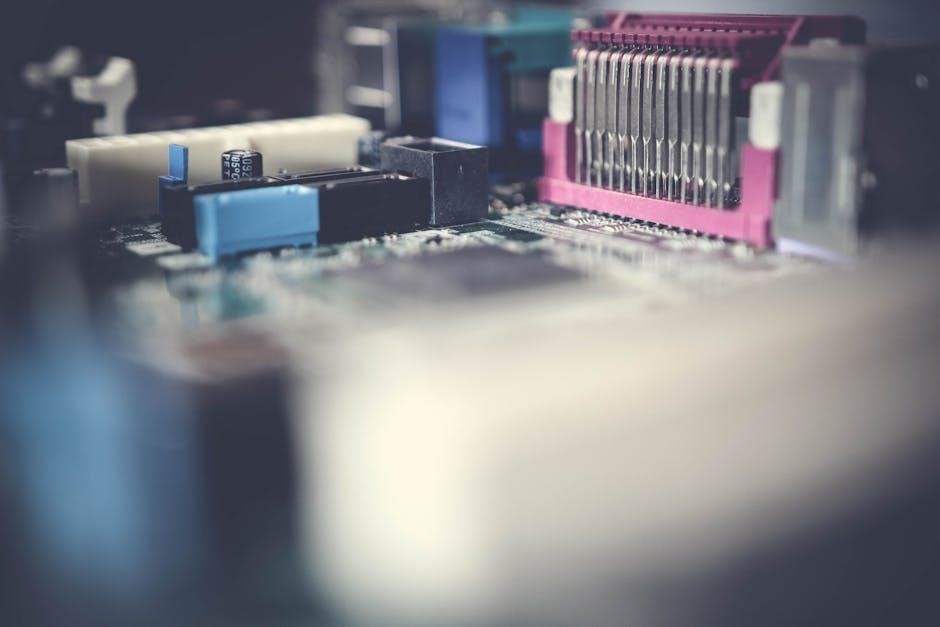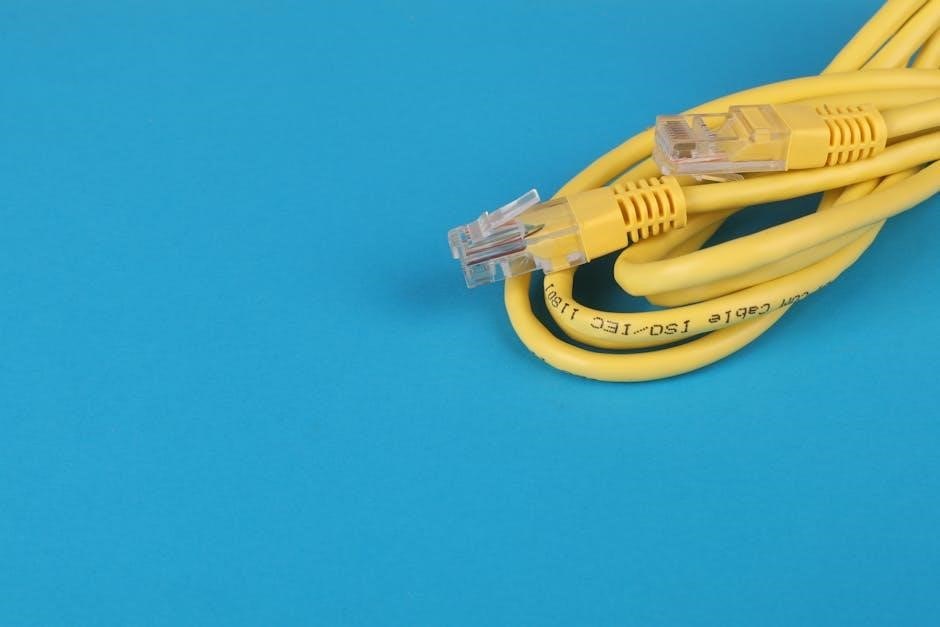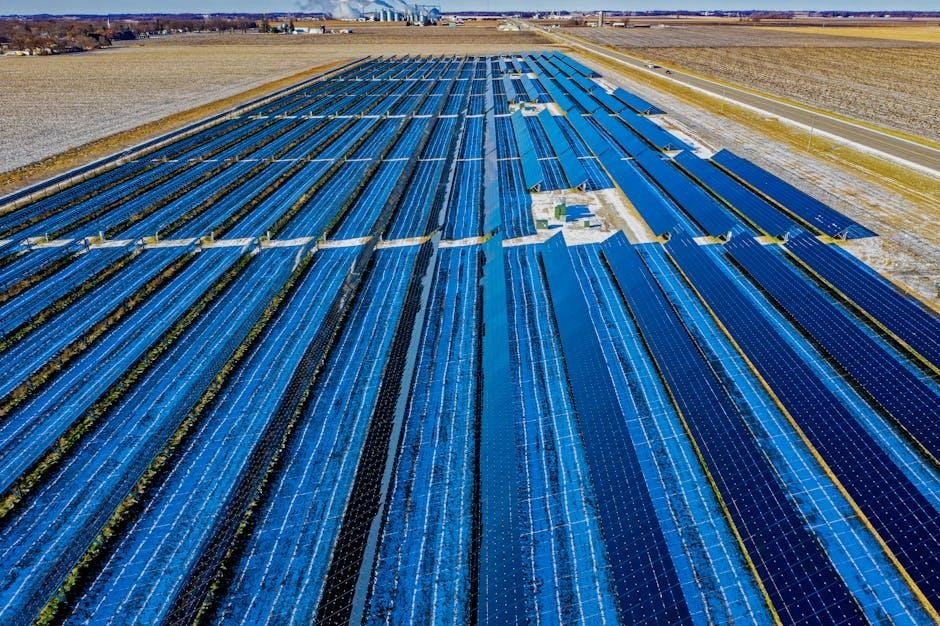
Off-grid solar systems provide reliable energy independence by harnessing sunlight, storing it in batteries, and delivering power without grid reliance. Essential for remote locations, they ensure consistent energy access while reducing utility dependence. Proper wiring is crucial for safety, efficiency, and system longevity, making it a cornerstone of off-grid solar installations.
1.1 What is an Off-Grid Solar System?
An off-grid solar system is a standalone renewable energy solution designed to generate, store, and deliver electricity without reliance on a utility grid. It typically consists of solar panels, a charge controller, a battery bank, and an inverter. These components work together to capture sunlight, regulate energy flow, store excess power, and convert it for household use. Off-grid systems are ideal for remote locations, RVs, and homes seeking energy independence. Wiring diagrams are essential for proper installation, ensuring safety, efficiency, and optimal performance. They provide a clear blueprint for connecting all components correctly, making the system reliable and long-lasting.
1.2 Importance of Proper Wiring in Off-Grid Solar Systems
Proper wiring is critical in off-grid solar systems to ensure safety, efficiency, and reliability. Correct connections prevent electrical hazards, such as short circuits, overheating, and fire risks. Improper wiring can lead to energy loss, system inefficiency, and even complete failure. A well-designed wiring diagram guides the installation, ensuring all components (panels, charge controllers, batteries, and inverters) are connected safely and effectively. Using the right materials and following safety standards is essential to maximize system performance and longevity. Proper wiring also protects against overcurrent and voltage fluctuations, ensuring the system operates smoothly under various conditions.
Fundamental Concepts of Solar System Wiring
Understanding voltage, current, and power is essential for designing efficient off-grid solar systems. Series and parallel connections optimize energy flow, while charge controllers and battery banks ensure safe energy storage and distribution.
2.1 Understanding Voltage, Current, and Power in Solar Systems
Voltage, current, and power are foundational concepts in solar wiring. Voltage (V) represents the force driving electrons, while current (I) is the flow rate of electrons, measured in amperes (A). Power (P), in watts (W), is the product of voltage and current (P = V × I). In solar systems, voltage determines the potential energy, and current reflects the flow rate of energy. Proper management of these elements ensures efficient energy transfer and safe operation. Solar panels produce DC voltage, which charge controllers regulate to prevent overcharging. Batteries store energy based on voltage and current, making accurate wiring crucial for optimal performance and safety.
2.2 Series vs. Parallel Connections in Solar Panels
In solar panel connections, series and parallel configurations serve different purposes. Series connections increase total voltage while maintaining current, suitable for higher voltage needs like charging battery banks. Parallel connections maintain voltage but increase current, ideal for applications requiring more power. Hybrid systems combine both, offering flexibility in voltage and current optimization. Series connections are efficient for MPPT charge controllers, while parallel setups reduce the impact of underperforming panels. Safety considerations include appropriate wiring for voltage and current levels, ensuring efficient and safe solar system operation.
2.3 Role of Charge Controllers in Off-Grid Systems
Charge controllers are essential for regulating energy flow from solar panels to batteries, preventing overcharging and ensuring safe operation. They optimize energy transfer, protecting the battery bank from voltage spikes and excessive current. Modern controllers, like MPPT (Maximum Power Point Tracking), maximize solar panel efficiency by converting excess voltage into usable current. Proper installation and sizing of charge controllers are critical for system performance, ensuring reliable energy storage and distribution. They act as a gateway between solar panels and batteries, safeguarding the entire off-grid system and enhancing its overall efficiency and longevity.
2.4 Battery Bank Configuration and Wiring
Battery banks are pivotal in off-grid solar systems for energy storage. Configuring them involves series or parallel wiring to achieve desired voltage and capacity. Series connections increase voltage, while parallel wiring boosts capacity. Proper wiring ensures balanced charging and discharging, critical for longevity. Safety and efficiency hinge on correct configuration, avoiding overvoltage or undercharging. Detailed wiring diagrams guide precise connections, ensuring the system operates reliably. Correct battery bank setup is vital for consistent power supply, making it a cornerstone of off-grid energy systems. Proper configuration and wiring ensure energy availability and system durability.
Key Components of an Off-Grid Solar System
Off-grid solar systems rely on solar panels, charge controllers, deep-cycle batteries, inverters, and wiring to store and deliver energy efficiently. Proper installation ensures reliability and safety.
3.1 Solar Panels and Their Specifications
Solar panels are the cornerstone of off-grid systems, converting sunlight into electricity. They come in monocrystalline or polycrystalline types, with varying efficiencies. Panels typically operate at 12V, 24V, or 48V, depending on system design. Power ratings range from 200W to 400W per panel, with higher wattage offering greater energy output. Series and parallel connections allow customization to meet energy needs. Specifications like short circuit current, open circuit voltage, and maximum power point voltage are critical for wiring diagrams; Ensuring compatibility and optimal performance is vital for efficient energy generation and safe system operation;
3.2 Charge Controllers: Types and Functions
Charge controllers regulate energy flow from solar panels to batteries, preventing overcharging and ensuring optimal energy storage. They come in two main types: PWM (Pulse Width Modulation) and MPPT (Maximum Power Point Tracking). PWM controllers are cost-effective and suitable for small systems, while MPPT controllers offer higher efficiency by extracting maximum power from panels, especially in varying conditions. Both types provide essential functions like voltage regulation, overcharge protection, and monitoring capabilities. Proper sizing and configuration of charge controllers are critical for system efficiency and longevity, ensuring safe and reliable energy management in off-grid solar setups.
3.3 Deep Cycle Batteries for Energy Storage
Deep cycle batteries are specifically designed for off-grid solar systems, storing excess energy generated by solar panels for later use. Unlike standard batteries, deep cycle batteries can handle repeated charging and discharging cycles, making them ideal for energy storage in remote setups. They offer high capacity and durability, ensuring reliable power supply during periods of low sunlight or at night. Proper sizing and configuration of the battery bank are critical to meet energy demands, and regular maintenance is essential to maximize their lifespan and performance in off-grid applications.
3.4 Inverters and Their Role in Off-Grid Systems
Inverters are essential components in off-grid solar systems, converting DC power from solar panels and batteries into AC power for household appliances. They ensure compatibility between the solar-generated energy and the electrical devices they power. Inverters also regulate voltage and frequency, maintaining safe and stable power output. Proper sizing and installation of inverters are critical to optimize system performance and prevent energy loss. They work in conjunction with charge controllers and battery banks to provide a reliable energy supply, making them a cornerstone of off-grid solar functionality and efficiency.
3.5 Circuit Breakers and Fuses in Solar Wiring
Circuit breakers and fuses are critical components in off-grid solar systems, protecting the wiring and components from overcurrent conditions. They act as safety devices, preventing damage from short circuits or power surges. Properly sized circuit breakers ensure reliable operation, while fuses provide an additional layer of protection. High-quality, DC-rated circuit breakers are essential for off-grid systems to handle the unique demands of solar energy. Regular inspection and maintenance of these devices are vital to ensure the system remains safe and efficient. Their correct installation and sizing are key to safeguarding the entire solar setup and preventing potential hazards.
3.6 Wiring and Cables: Selection and Safety
Proper selection and installation of wiring and cables are vital for the safe and efficient operation of an off-grid solar system. Correct wire sizing ensures minimal voltage drop and prevents overheating, while appropriate insulation and material quality protect against environmental factors. UV-resistant cables are recommended for outdoor use to maintain durability. Color coding helps in identifying positive, negative, and ground wires, enhancing safety. Always follow safety guidelines, such as using DC-rated circuit breakers and avoiding overloaded circuits. Regular inspection of wiring and connections is essential to prevent faults and ensure compliance with electrical standards.

Designing an Off-Grid Solar System
Designing an off-grid solar system involves load analysis, energy requirements assessment, and sizing solar panels and batteries. Proper configuration ensures reliability and scalability for energy needs.
4.1 Load Analysis and Energy Requirements
Load analysis is the first step in designing an off-grid solar system, determining the total energy consumption of all appliances and devices. This involves calculating the power and energy requirements of each load, including lighting, refrigeration, and electronics. By summing up the wattage of all devices and their daily usage hours, you can estimate the total energy needed in watt-hours (Wh). This analysis ensures the solar system is sized correctly to meet demand, even during periods of low sunlight. Accurate load analysis prevents undersizing or oversizing the system, optimizing performance and cost efficiency while ensuring reliable energy supply.
4.2 Sizing the Solar Panel Array and Battery Bank
Sizing the solar panel array and battery bank is critical for ensuring the system meets energy demands. Start by calculating the total daily energy load, typically in watt-hours (Wh). For example, if your daily energy requirement is 2000Wh, the solar array should generate at least this amount, considering factors like peak sun hours and efficiency losses. Battery capacity is sized to store excess energy for nighttime use and cloudy days, often requiring a 24-48 hour reserve. Proper sizing ensures reliable power supply and prevents system overload or insufficient energy storage.
4.3 System Configuration: Series, Parallel, and Hybrid
Configuring an off-grid solar system involves arranging components in series, parallel, or hybrid setups. Series connections increase voltage while keeping current low, suitable for charging batteries efficiently. Parallel connections maintain voltage while increasing current, ideal for higher energy demands. Hybrid systems combine series and parallel configurations, offering flexibility for varying needs. Proper configuration ensures optimal energy flow, balancing voltage and current for efficient charging and power delivery. Load analysis and energy requirements guide the selection of the most suitable configuration. Correct setup is essential for system efficiency, safety, and reliability, ensuring energy needs are consistently met.
Wiring Diagrams for Off-Grid Solar Systems
Wiring diagrams provide visual representations of electrical connections for off-grid solar systems, ensuring safe and efficient installations. They detail connections for solar panels, charge controllers, batteries, and inverters, guiding proper setup and minimizing hazards.
5.1 Basic Off-Grid Solar Wiring Diagram
A basic off-grid solar wiring diagram illustrates the fundamental connections between components. It typically shows solar panels connected in series or parallel to a charge controller, which regulates power to the battery bank. The battery bank is then linked to an inverter, converting stored energy into usable AC power. This diagram provides a clear, simplified overview, ensuring that each component is correctly connected for safe and efficient energy flow. Proper wiring as per the diagram is essential to avoid system malfunctions and ensure reliability.
5.2 Solar Panel Array Wiring Diagram
A solar panel array wiring diagram details how panels are connected to achieve desired voltage and current levels. Panels can be wired in series to increase voltage or in parallel to boost current, depending on system requirements. The diagram shows connections between panels, ensuring proper polarity and alignment. It also illustrates how the array links to the charge controller and battery bank. Correct wiring ensures maximum energy efficiency and system safety. This visual guide is essential for installing and troubleshooting solar panel configurations, helping users optimize energy production.
5.3 Battery Bank Wiring Diagram
A battery bank wiring diagram illustrates how batteries are interconnected to store energy for an off-grid solar system; It shows series and parallel configurations to achieve the desired voltage and capacity. The diagram details connections between batteries, ensuring proper polarity and safety. It also outlines how the battery bank links to the inverter and charge controller. This visual guide helps in understanding energy storage setup, ensuring efficient and safe system operation. Proper wiring is crucial for maximizing battery life and system performance, making this diagram essential for installation and troubleshooting.
5.4 Inverter and Charge Controller Wiring Diagram
An inverter and charge controller wiring diagram details the connections between solar panels, batteries, and the inverter. It illustrates how the charge controller regulates energy flow from panels to batteries and ensures overcharge protection. The inverter converts stored DC power to AC for appliances. The diagram shows wiring for input/output terminals, grounding, and safety devices like fuses or circuit breakers. Proper connections ensure efficient energy transfer, system safety, and optimal performance. This visual guide is essential for installing and troubleshooting off-grid solar systems, helping users avoid common wiring errors.

Safety Considerations in Off-Grid Solar Wiring
Proper grounding, overcurrent protection, and safe wiring practices are crucial to prevent electrical hazards. Always follow diagrams and guidelines to ensure system safety and reliability.
6.1 Electrical Safety Precautions
Electrical safety is paramount in off-grid solar systems to prevent hazards like shocks, fires, or equipment damage. Always disconnect power sources before performing maintenance. Use properly rated circuit breakers and fuses to protect against overcurrent conditions. Ensure all connections are secure and insulated to avoid short circuits. Grounding and bonding are critical to safeguard against voltage surges and ensure safe operation. Follow wiring diagrams and manufacturer guidelines to maintain system integrity. Regularly inspect wiring and components for wear or damage. Never compromise on safety standards, as improper wiring can lead to catastrophic failures and safety risks.
6.2 Grounding and Bonding in Solar Systems
Grounding and bonding are critical for ensuring the safety and efficiency of off-grid solar systems. Proper grounding protects against voltage surges and electrical shocks by providing a safe path for fault currents. Bonding ensures all system components, such as solar panels, inverters, and battery banks, are at the same electrical potential, preventing dangerous voltage differences. Use copper wires and rod electrodes for reliable grounding. Regularly inspect grounding connections to prevent corrosion. Follow local electrical codes and wiring diagrams to ensure correct implementation. Proper grounding and bonding are essential for system stability and user safety in off-grid solar installations.
6.3 Overcurrent Protection Devices
Overcurrent protection devices, such as circuit breakers and fuses, are essential for safeguarding off-grid solar systems from damage caused by excessive current. These devices detect and interrupt overcurrent conditions, preventing electrical fires and component damage. Install them in series with solar panels, battery banks, and inverters to ensure comprehensive protection. Proper sizing of fuses and circuit breakers is critical to avoid unnecessary tripping while maintaining safety. Use high-quality, UL-rated components to ensure reliability. Always follow the wiring diagram and manufacturer guidelines for installation. Overcurrent protection is a vital layer of safety in any off-grid solar system, ensuring longevity and operational integrity.

Tools and Materials for Solar Wiring
Essential tools include wire strippers, multimeters, and crimpers. Materials like high-quality cables, circuit breakers, and connectors ensure safe and efficient connections. Proper tools and materials are critical for reliable solar wiring.
7.1 Essential Tools for DIY Solar Wiring
For a successful DIY solar wiring project, essential tools include multimeters, wire strippers, crimpers, and screwdrivers. A multimeter helps measure voltage, current, and resistance, ensuring safe connections. Wire strippers are crucial for preparing cables, while crimpers secure connections. Pliers and screwdrivers aid in tightening and loosening components. High-quality cables, circuit breakers, and connectors are also vital. These tools ensure proper installation, safety, and efficiency. Using the right tools prevents errors and guarantees a reliable off-grid solar system. Always prioritize quality to avoid electrical hazards and maintain system performance.
7.2 Recommended Materials for Solar System Installation
For a reliable off-grid solar system, high-quality materials are essential. Solar panels should be durable, with options like monocrystalline or polycrystalline. Charge controllers and inverters must match system voltage and power needs. Deep cycle batteries, such as AGM or lithium, are ideal for energy storage. Proper wiring, including UV-resistant cables, ensures safe connections. Mounting hardware, like racks and clamps, secures panels. Bus bars and connectors facilitate efficient energy flow. Grounding materials, such as rods and clamps, are vital for safety. Weatherproof enclosures protect components from environmental stress. Using the right materials ensures system longevity and performance.

Applications of Off-Grid Solar Systems
Off-grid solar systems are ideal for remote homes, cabins, RVs, and agricultural applications, providing energy independence and reducing reliance on traditional power sources while promoting sustainability.
8.1 RV and Camper Van Solar Wiring Diagrams
RV and camper van solar wiring diagrams provide a clear guide for installing solar panels, charge controllers, batteries, and inverters; These diagrams ensure safe and efficient energy generation, storage, and usage. They typically include series or parallel connections for solar panels, appropriate wire gauges, and necessary circuit breakers and fuses. Proper grounding is essential for safety, and wire labeling helps in easy troubleshooting. Detailed diagrams help RV owners to follow a proven layout, ensuring all components are correctly connected for optimal performance and safety. Always prioritize secure connections and test the system step-by-step to avoid electrical hazards.
8.2 Off-Grid Solar Systems for Cabins and Remote Homes
Off-grid solar systems are ideal for cabins and remote homes, offering energy independence and reduced reliance on utility grids. These systems harness sunlight to power lighting, appliances, and heating, making them perfect for secluded areas. A well-designed solar array, battery bank, and inverter ensure consistent energy supply. Proper wiring, including correct wire sizing and grounding, is essential for safety and efficiency. Remote homes benefit from renewable energy, lowering costs and environmental impact. Detailed wiring diagrams guide installation, ensuring all components are connected securely for reliable off-grid power in even the most isolated locations.
8.3 Solar Power for Agricultural and Rural Applications
Solar power is a vital solution for agricultural and rural areas, providing reliable energy for irrigation, water pumping, and farm equipment. Off-grid solar systems enable farmers to reduce energy costs and maintain operations in remote locations. Wiring diagrams ensure proper connections between solar panels, charge controllers, batteries, and inverters. These systems are ideal for powering barns, fencing, and lighting. By harnessing renewable energy, farmers can reduce reliance on fossil fuels and lower operational expenses. Detailed wiring guides help in setting up efficient and safe solar installations tailored to agricultural needs, ensuring continuous productivity in rural settings.
Maintenance and Troubleshooting
Regular maintenance ensures off-grid solar systems operate efficiently. Clean solar panels, check battery connections, and inspect wiring for damage. Troubleshoot issues like low voltage or faulty inverters promptly to avoid downtime and system damage.
9.1 Regular Maintenance Checks for Off-Grid Systems
Regular maintenance checks are essential for ensuring the longevity and efficiency of off-grid solar systems. Start by inspecting solar panels for dust, dirt, or damage, and clean them as needed. Check the charge controller and inverter for any error codes or unusual readings. Verify battery voltage levels and ensure all connections are secure. Inspect wiring for signs of wear or damage, and test circuit breakers to ensure they function properly. Refer to your wiring diagram to trace connections and identify potential issues. Regular maintenance helps prevent system failures and ensures consistent energy production.
9.2 Common Issues in Solar Wiring and Solutions
Common issues in solar wiring include loose connections, overloading, and corroded wires. Loose connections can cause power loss and fire hazards, so tighten them regularly. Overloaded circuits may trip breakers or damage components; ensure wiring is appropriately sized. Corroded wires can disrupt energy flow and pose safety risks; replace them promptly. Consult your wiring diagram to trace and resolve issues efficiently. Regular inspections and proactive maintenance are key to preventing these problems and ensuring system reliability and safety.

Advanced Topics in Off-Grid Solar Wiring
Explore smart monitoring systems and battery management systems (BMS) for enhanced performance. These technologies optimize energy storage, improve safety, and ensure efficient solar system operation.
10.1 Smart Monitoring Systems for Off-Grid Solar
Smart monitoring systems enhance off-grid solar efficiency by providing real-time data on energy production, consumption, and storage. These systems use sensors and software to track key metrics such as voltage, current, and power, ensuring optimal performance. Remote access via smartphones or computers allows users to monitor their system’s status, receive alerts for issues, and adjust settings for better energy management. Advanced analytics help identify trends and potential problems, enabling proactive maintenance. Integration with battery management systems (BMS) further improves energy storage and overall system reliability, making smart monitoring a vital tool for modern off-grid solar setups.
10.2 Battery Management Systems (BMS)
A Battery Management System (BMS) is crucial for optimizing energy storage in off-grid solar setups. It monitors voltage, temperature, and state of charge for each battery cell, ensuring balanced charging and discharging. The BMS prevents overcharging or deep discharging, which can damage batteries and reduce their lifespan. Advanced BMS solutions also provide real-time data, enabling better energy management and system efficiency. By protecting the battery bank from potential faults, a BMS enhances overall system reliability and longevity, making it an essential component for off-grid solar installations.
Future Trends in Off-Grid Solar Technology
Emerging technologies like advanced energy storage systems and smart inverters are revolutionizing off-grid solar, improving efficiency, reliability, and sustainability for remote energy solutions.
11.1 Emerging Technologies in Solar Energy Storage
Emerging technologies in solar energy storage are transforming off-grid systems, with advancements like lithium-ion batteries and solid-state batteries offering higher efficiency and longer lifespans. Battery Management Systems (BMS) optimize energy storage by monitoring and balancing battery cells, ensuring safety and performance. Flow batteries are also gaining traction for their scalability and long-duration energy storage capabilities. These innovations enhance system reliability, reduce maintenance needs, and improve overall energy independence, making off-grid solar more viable for remote and rural applications. Smart integration with inverters and charge controllers further streamlines energy management, paving the way for a sustainable energy future.
11.2 Advancements in Inverter and Charge Controller Technology
Advancements in inverter and charge controller technology are revolutionizing off-grid solar systems. Smart inverters now offer multi-mode operation, seamlessly transitioning between grid and off-grid power. High-efficiency MPPT charge controllers maximize energy harvesting from solar panels, while advanced monitoring systems provide real-time performance data. These technologies enable better energy management, higher system efficiency, and improved reliability. Smart integration with battery management systems ensures optimal energy storage and distribution, making off-grid solar systems more robust and user-friendly. Such innovations are critical for enhancing the performance and sustainability of off-grid energy solutions.
Additional Resources and References
Download detailed PDF guides like “DIY Off-Grid Solar Wiring Diagram.pdf” and explore online forums such as EXPLORIST.life for comprehensive support and resources on solar system wiring.
12.1 Recommended PDF Guides for Off-Grid Solar Wiring
Download essential PDF guides like “DIY Off-Grid Solar Wiring Diagram.pdf” and “Solar Panel Array Configuration.pdf” for detailed wiring diagrams and step-by-step instructions. These resources provide practical insights into configuring solar systems, including battery banks and inverters. Additionally, “Solar Panel Array Wiring.pdf” and “28kWH Battery Bank Configuration.pdf” offer in-depth technical details. Visit forums like EXPLORIST.life for community-shared PDFs and expert advice. These guides are invaluable for safe and efficient off-grid solar installations, ensuring your system is properly wired and optimized for performance.
12.2 Online Communities and Forums for Support
Online forums and communities are invaluable for troubleshooting and optimizing off-grid solar systems. Platforms like EXPLORIST.life offer extensive libraries of wiring diagrams and user experiences. Reddit’s r/offgridsolar and specialized solar forums provide spaces to share knowledge and resolve technical challenges. These communities often include tutorials, diagrams, and expert advice. Engaging with these groups can help you refine your system design and address common issues. Active participation in forums ensures access to the latest trends and solutions, making them a vital resource for both beginners and experienced installers of off-grid solar systems.